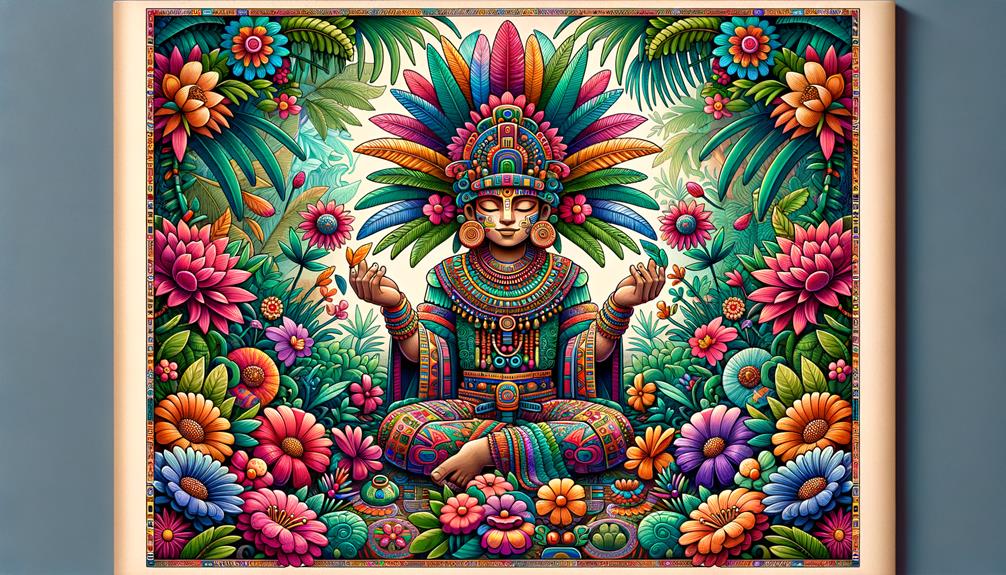Xochipilli, a figure parallel to the ancient Greek Muses, embodies the essence of art and nature. Examining the vivid flower symbolism in his depictions, these blooms portray more than mere beauty – they reflect life's cyclical nature and creativity's spark. Xochipilli, draped in petals and feathers, personifies transformation and inspiration. His presence prompts us to ponder the delicate dance between humanity and the divine realms. What profound insights might we gain by tracing the petals of his mythical odyssey?
Symbolism of Flowers
In Aztec mythology, flowers burst forth as potent symbols of fertility and interconnectedness, intricately tied to life's cycle under Xochipilli's watchful gaze. As the flower prince and deity, Xochipilli represents life's joys and creative energies. His connection to flowers extends beyond beauty, delving into their mystical significance.
Vibrant flowers, particularly from psychoactive plants, often surround depictions of Xochipilli, personifying spiritual enlightenment. These plants were thought to open pathways to other realms, enhancing the bond between the physical and spiritual dimensions. The presence of flowers in his iconography confirms their role in rituals seeking transcendence and divine communion.
Xochipilli's association with these elements reflects Aztec reverence for nature's cycles, where life, death, and rebirth intertwine eternally. Under his domain, flowers symbolize not just fertility but the creativity and pleasure inherent in existence. They remind us of the beauty and interconnectedness of all life forms, echoing Xochipilli's influence over artistic inspiration and the delicate natural balance.
Artistic Depictions
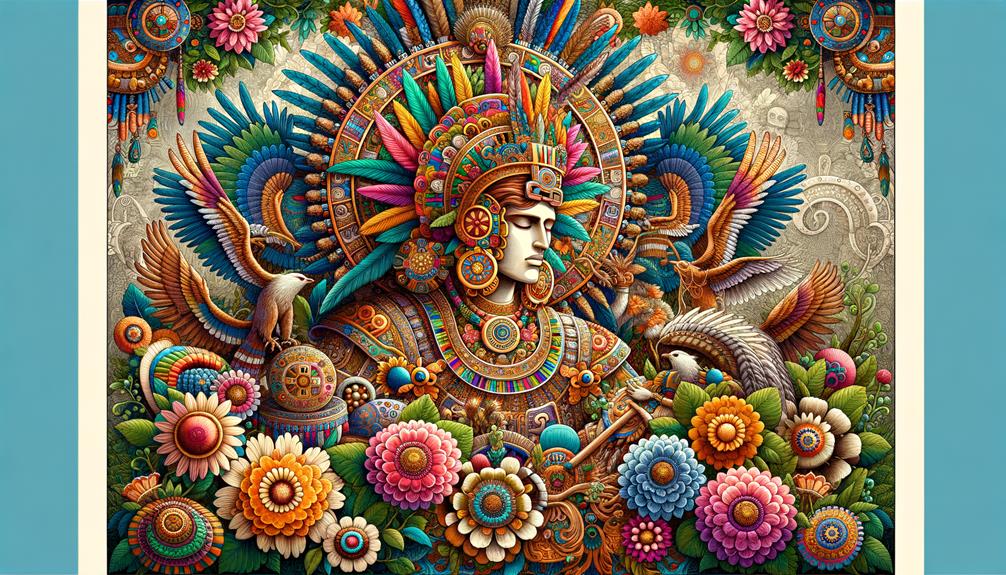
Artistic interpretations of Xochipilli, the Aztec deity of joy and nature, transport us to a vibrant realm where the divine and natural worlds intertwine. His figure, frequently adorned with a feathered headdress and mask, symbolizes his sacred status. Vibrant hues paint his body, reflecting his dominion over celebration and creative expression. Flowers, butterflies, and birds surround him, embodying transformation, beauty, and the ethereal.
These artworks convey profound meaning through their symbolism. Shells and jade adornments signify purity and immortality, reinforcing Xochipilli's sacred role. Each piece captures the essence of human creativity, bridging the gap between the mortal and divine realms. Artists channel the god's spirit, inviting us to revel in the ecstasy of nature's splendor and life's pleasures.
Xochipilli's artistic representations are not mere aesthetic objects; they are gateways into a world where flora and deity unite in an exhilarating dance. Each brushstroke and sculptural detail resonates with the deity's essence, evoking the transformative power of artistic expression and the reverence for nature's boundless beauty.
Cultural Significance
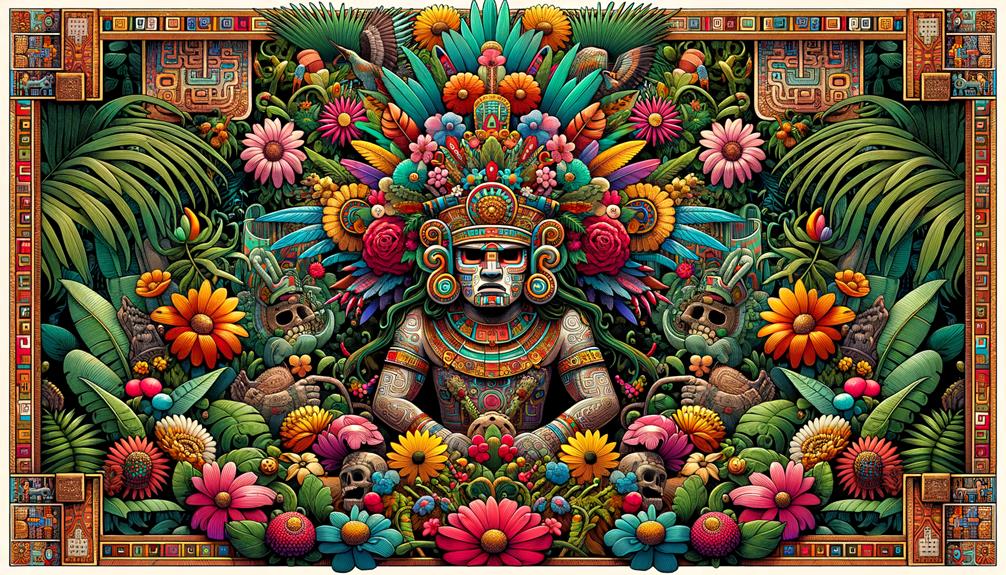
Xochipilli's roots trace back to Aztec mythology, where he represents the intertwining of nature, music, and artistic expression. As an Aztec deity, he personifies these vibrant realms, symbolizing a harmonious existence where beauty and creativity thrive. His depictions, often adorned with flowers, reflect this joyous union.
Flowers aren't mere decorations in Xochipilli's imagery; they're symbolic of fertility, joy, and artistic inspiration. In Aztec mythology, these plants represent the life force and creative energy Xochipilli bestows upon the world. His presence in art highlights his role as a patron of painters, musicians, and artists, underscoring the arts' significance in Mesoamerican cultures.
The use of flowers reinforces Xochipilli's connection to nature, beauty, and the arts, serving as a visual metaphor for the boundless creativity he inspires. His cultural significance extends beyond history, becoming an archetype illustrating the timeless human pursuit of beauty and artistic expression amidst the natural world.
Modern Interpretations
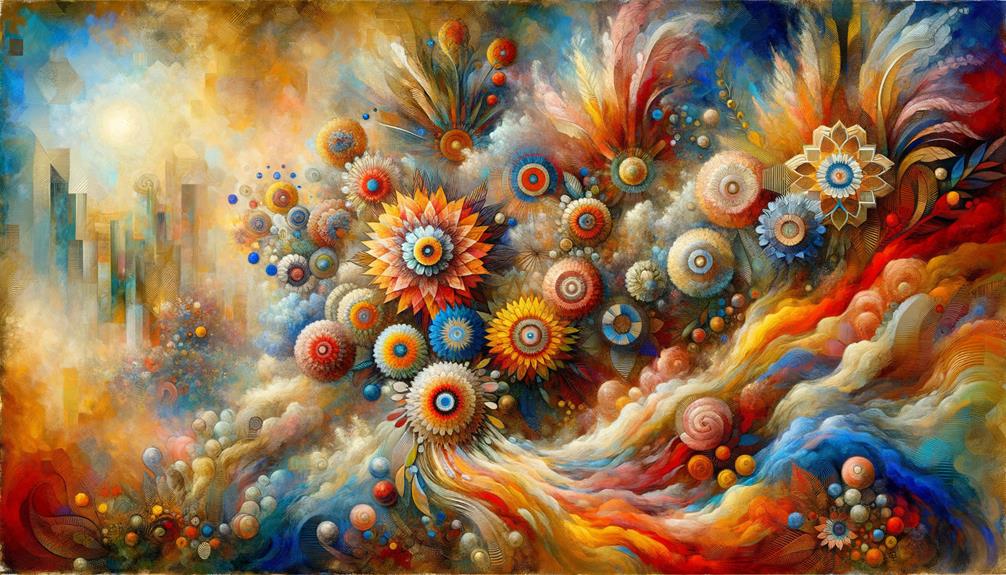
Modern artists like Martine Gutierrez reinterpret Xochipilli's essence, challenging contemporary ideas around gender and artistic expression. On a journey of self-discovery, Gutierrez channels Xochipilli, the Aztec deity of art and flowers, exploring her identity as a trans woman. Her portrayal boldly confronts rigid gender norms, embodying both masculinity and femininity.
Adorned in a pink ahuipil and metallic flowers, Gutierrez transforms Xochipilli into a symbol of gender fluidity. This campy aesthetic feminizes the traditionally masculine deity while celebrating the spectrum of gender performativity, echoing Judith Butler's theories. Gutierrez's art melds the masculine and feminine, defying conventional binaries.
Her portrayal intersects themes of inclusivity and self-expression, urging society to reconsider predefined notions of gender. By embodying Xochipilli, Gutierrez invites viewers on a mythological journey, where each accessory and garment symbolizes progress towards a more inclusive understanding of identity. Through her art, she redefines the divine archetype as a powerful narrative of gender fluidity and self-empowerment.
Xochipilli in Mythology
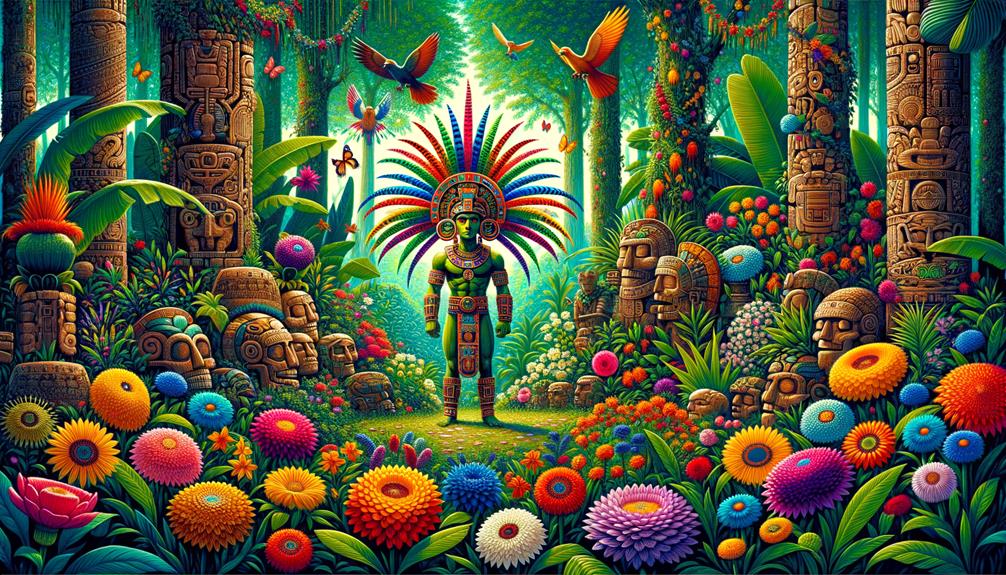
Xochipilli, the Flower Prince of Aztec mythology, embodies life's joys and creativity – a symbol of art, music, dance, and nature's beauty. His name blends the Nahuatl words for 'flower' and 'prince,' reflecting his essence as the son of the earth goddess Tlazolteotl and sun god Tonatiuh. Depicted adorned with floral garb and hallucinogenic plants, Xochipilli represents enhanced perception and spiritual euphoria, donning the oyohualli talisman signifying divine connection.
Xochipilli inspires artistic expression through music and movement, infusing rhythm and grace. Flowers underscore existence's fleeting yet exquisite nature, while hallucinogenic plants facilitate visionary experiences linking the earthly and spiritual realms. Through these motifs, the Flower Prince exemplifies Aztec ideals of celebrating life's pleasures and embracing creativity's transformative power.
Frequently Asked Questions
What Does Xochipilli Symbolize?
Xochipilli encapsulates art, beauty, music, and nature's wonders. This vibrant deity celebrates life's joys, love's blossoming, and the profound interconnectedness between all beings. Artistic renderings often depict Xochipilli adorned with psychotropic plants, symbolic of heightened consciousness and perception. A quintessential embodiment of beauty's diverse expressions, Xochipilli invites us to embrace life's richness fully.
Who Is the Aztec God of Flowers?
The Aztec god of flowers goes by Xochipilli, dubbed the Flower Prince. His embodiment celebrates joy, beauty, and creativity – guiding through the inspiring journey of artistic expression by connecting human experiences with nature's divine splendor.
What Is the Symbol of the Xochiquetzal Flower?
The Xochiquetzal flower, intertwined with Aztec legends of creativity and allure, stands for beauty, fertility, and artistic inspiration. It embodies nature's grace seamlessly blending with human love and talent.
Who Is the Goddess of Flowers Mexico?
Xochiquetzal, the Mexican goddess of flowers, beauty, love, and fertility, epitomizes the interconnection between nature, creativity, and feminine empowerment. Her story resonates through every blossom, butterfly, and intricately woven artwork, reflecting the profound symbolism embodied by this archetypal figure.

